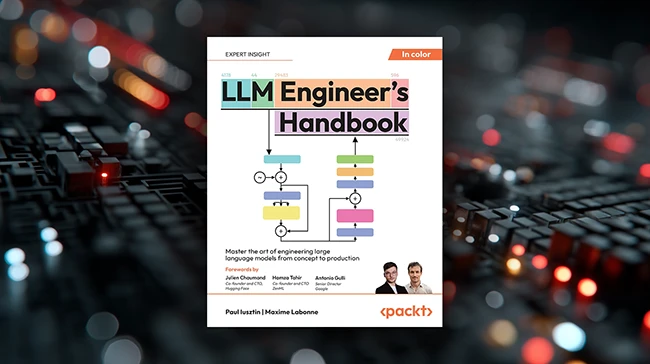Review: LLM Engineer’s Handbook
For all the excitement around LLMs, practical, engineering-focused guidance remains surprisingly hard to find. LLM Engineer’s Handbook aims to fill that gap.
About the authors
Paul Iusztin is a Senior AI Engineer and founder of Decoding ML, a channel for content on learning how to design, code, and deploy production-grade ML.
Maxime Labonne is the Head of Post-Training at Liquid AI, and He holds a Ph.D. in Machine Learning from the Polytechnic Institute of Paris.
Inside the book
The authors walk you through how to design, build, and deploy a production-grade LLM application, specifically an “LLM twin” that writes in your personal style using your digital data. The book frames this twin as a tool to help you build your personal brand, automate social media content, and brainstorm ideas. It’s upfront about the limitations: the model isn’t you, it’s a projection trained on what you’ve written online. That’s the baseline assumption, and it sets the tone for the rest of the book, which is practical, cautious, and focused on real-world tradeoffs.
From there, the authors walk readers through the full stack: data collection, feature pipelines, training and inference pipelines, and system design. One strength is how they separate concerns. Data engineering and ML engineering are treated as distinct, and the book sticks closely to the feature/training/inference (FTI) pipeline architecture throughout. This pattern serves as the backbone for the whole system and will be familiar to engineers who have worked on other ML projects.
Much of the book reads like internal documentation from an AI startup. You’ll find detailed breakdowns of system requirements, tooling considerations, and architectural decisions. For example, instead of assuming access to a massive GPU cluster, the authors design their LLM twin MVP around realistic constraints: a small team, limited compute, and a narrow set of features. That includes crawling personal content from sites like LinkedIn or GitHub, building instruct datasets, populating a vector store for retrieval-augmented generation (RAG), and fine-tuning an open-source model. The result is not just a theoretical walkthrough but a practical roadmap that is grounded in the kinds of compromises most teams experience.
The book assumes readers are already somewhat familiar with LLM concepts, vector databases, and MLOps patterns. It is not a beginner’s guide, and some sections may feel dense if you haven’t worked on ML systems before. There are also places where the moral and privacy implications of LLM twins are acknowledged but not deeply explored.
Still, the book’s core value lies in how it demystifies the nuts and bolts of LLM product development. Rather than chasing benchmarks or open-ended research, it focuses on building something useful, contained, and repeatable. That alone makes it stand out in a market flooded with either high-level AI books for executives or highly academic deep dives.
Who is it for?
If you’re part of an engineering team building with LLMs, or trying to evaluate what such a system involves, LLM Engineer’s Handbook is worth a close read. It won’t answer every question, but it will give you a framework to think through the architecture, tooling, and workflows involved in turning an LLM into a working product.
